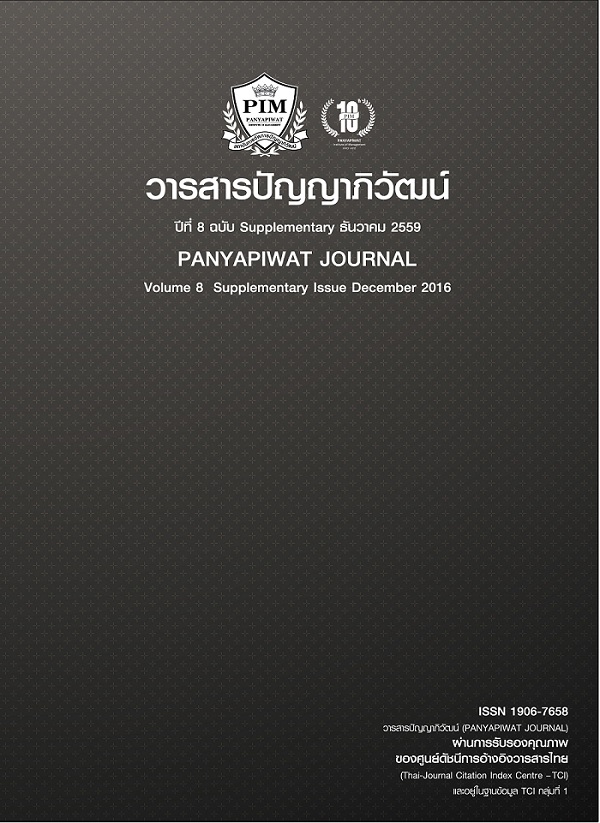THE ENGLISH LISTENING-SPEAKING CORNERSTONES
Main Article Content
บทคัดย่อ
This quantitative research aims to improve students’ language competency. Four-different-area focus tools: “True Calling” (pronunciation), “Drop Me Off” (stressing), “Pick Me Up” (listening comprehension), and “Speak It Out” (speaking) were used to help students mitigate their weak learning areas and strengthen both receptive (listening) and productive (speaking) skills. Prior to the experiment, TOEIC test were used as a pretest and post test. Sixty-seven students in the Conversational English classes were chosen to be participants. This research began with the pronunciation, stressing, Listening comprehension, speaking tools consecutively. This research also includes the interview sessions of three American educators. In addition, the questionnaire helped the researcher understand the participants’ background language competency and individual interests towards the focused communicative skills. The results show that the participants performed better in some areas. In further research, some factors should be focused more on the background environment, with native English speakers (as peers) and on more demanding immersion situations.
งานวิจัยนี้มีวัตถุประสงค์เพื่อพัฒนาความสามารถทางภาษาของนักศึกษา โดยการเน้นทักษะการฟัง การออกเสียง การเน้นเสียงหนัก-เบาและการพูด โดยใช้เครื่องมือ 4 ชนิด คือ “True Calling” (การออกเสียง) “Drop Me Off” (การเน้นเสียงหนัก-เบา) “Pick Me Up” (การฟัง) และ “Speak It Out” (การพูด) เครื่องมือเหล่านี้จะช่วยลดจุดอ่อนในการเรียนของนักศึกษา ในงานวิจัยนี้คือ นักศึกษา จำนวน 67 คน ที่เรียนในรายวิชาสนทนาภาษาอังกฤษ การวิจัยมีการสอบ pre-test และ post-test โดยใช้ข้อสอบ TOEIC หลังจากนั้นเครื่องมือ 4 ชนิดดังกล่าวได้ถูกนำมาใช้โดยเริ่มจากการออกเสียง การเน้นเสียงหนัก-เบา การฟัง และการพูดโดยลำดับ ในงานวิจัยนี้มีการสัมภาษณ์ผู้ให้การศึกษาชาว อเมริกัน 3 ท่าน นอกจากนี้แบบสอบถามภูมิหลังความสามารถในภาษาอังกฤษของนักศึกษาทำให้เข้าใจ ความสนใจด้านทักษะการฟัง-พูดของนักศึกษาแต่ละคน ผลการวิจัยแสดงให้เห็นว่า กลุ่มตัวอย่างมี พัฒนาการในบางทักษะ แต่ขณะเดียวกันมีความก้าวหน้าน้อยในการใช้เครื่องมือบางอย่าง แต่ถึงกระนั้น กลุ่มตัวอย่างต้องการเวลามากกว่านี้เพื่อพัฒนาทักษะทางภาษาของตนเอง ในการศึกษาครั้งต่อไป ควรมีการพิจารณาปัจจัยที่เกี่ยวข้องกับสิ่งแวดล้อมภูมิหลัง โดยผู้ใช้ภาษาอังกฤษเป็นภาษาแม่ (เป็นผู้ประเมิน) และใช้สถานการณ์ ที่ทำให้กลุ่มตัวอย่างตั้งใจปฏิบัติมากขึ้น
Article Details
“ข้าพเจ้าและผู้เขียนร่วม (ถ้ามี) ขอรับรองว่า บทความที่เสนอมานี้ยังไม่เคยได้รับการตีพิมพ์และไม่ได้อยู่ระหว่างกระบวนการพิจารณาลงตีพิมพ์ในวารสารหรือแหล่งเผยแพร่อื่นใด ข้าพเจ้าและผู้เขียนร่วมยอมรับหลักเกณฑ์การพิจารณาต้นฉบับ ทั้งยินยอมให้กองบรรณาธิการมีสิทธิ์พิจารณาและตรวจแก้ต้นฉบับได้ตามที่เห็นสมควร พร้อมนี้ขอมอบลิขสิทธิ์บทความที่ได้รับการตีพิมพ์ให้แก่สถาบันการจัดการปัญญาภิวัฒน์หากมีการฟ้องร้องเรื่องการละเมิดลิขสิทธิ์เกี่ยวกับภาพ กราฟ ข้อความส่วนใดส่วนหนึ่งและ/หรือข้อคิดเห็นที่ปรากฏในบทความข้าพเจ้าและผู้เขียนร่วมยินยอมรับผิดชอบแต่เพียงฝ่ายเดียว”
References
Arndt, V., Harvey, P. & Nuttall, J. (2000). Alive to language: Perspectives on language awareness for English language teachers. New York: Cambridge University Press.
Arnold, J. (2000). Seeing through listening comprehension exam anxiety. TESOL Quarterly, 34(4), 777-786.
Brown, H. D. (2000). Principles of language learning and teaching (4th ed.). White Plains, NY: Addison Wesley Longman.
Brown, H. D. (2001). Teaching by principle: An interactive approach to language pedagogy (2nd ed.). White Plains, NY: Addison Wesley Longman.
Carruthers, R. (1987). In M. H. Long & J. C. Richards (Ed.). Methodology in TESOL: A book of readings.(p.193). Boston: Heinle & Heinle Publishers.
Elliott, A. R. (1997). On the teaching and acquisition of pronunciation within a communicative approach. Hispania, 80(1), 95-108.
Gannaway, S. (2011, October 18). Interview. Master Tutor. Winona State University, Minnesota, USA.
Grove, C. (1999). Focusing on form in the communicative classroom: An output-centered model of instruction for oral skills development. Hispania, 82(4), 817-829.
Jung, E. H. (2003). The Role of discourse signaling cues in second language listening comprehension. Modern Language Journal, 87(4), 562-577.
Ko, J., Schallert, D. L. & Walters, K. (2003). Rethinking scaffolding: Examining negotiation of meaning in an ESL storytelling task. TESOL Quarterly, 37(2), 303-324.
Kwai, C. (2011, October 19). Interview. Asst. Director of International Services, Winona State University Minnesota, USA.
Lightbrown, P. M. & Spada, N. (2003). How language are learned. (2nd ed.). New York: Oxford University Press.
Moore, S. H. & Carreon, J. R. (2011). Hidden challenges that radio DJs present to ESL/EFL listeners. LITU Journal, 5, 1-7.
Nunan, D. (1999). Second language teaching and learning. Boston, MA: Heinle and Heinle.
O’Brien, M. G. (2004). Pronunciation matters. Die Unterrichtspraxis/Teaching German, 37(1), 1-9.
Pinker, S. (1994). The Language instinct: How the mind creates language. New York: Harper-Collin Publisher.
Richards, J. C. & Rodgers, T. S. (2001). Approaches and methods in language teaching (2nd ed.). New York: Cambridge University Press.
Richards, J. C. (1987). In M. H. Long & J. C. Richards (Ed.). Methodology in TESOL: A book of readings. (p.162). Boston: Heinle & Heinle Publishers.
Rost, M. (2008). Listening. In R. Carter & D. Nunan (Ed.). The Cambridge guide to Teaching English to Speakers of Other Languages. (pp.8-9). New York: Cambridge University Press.
Salaberry, M. R. & Lopez-Ortega, N. (1998). Accurate L2 production across language tasks: Focus on form, focus on meaning, and communicative control. The Modern Language Journal, 82(4), 514-532.
Saville-Troike, M. (2006). Introducing second language acquisition. New York: Cambridge University Press.
Scarcella, R. C. (1987). In M. H. Long & J. C. Richards (Ed.). Methodology in TESOL: A book of readings. (p.208-9). Boston: Heinle & Heinle Publishers.
Taguchi, N. (2005). Comprehending implied meaning in English as a foreign language. The Modern Language Journal, 89(4), 543-562.
Tananuraksakul, N. (2013). Power distance reduction and positive reinforcement: EFL learners’ confidence and linguistic identity. International Journal of Language Studies, 7(1), 103-116.
Vogel, B. (2011, October 21). Interview. Director of The De La Salle Language Institute. Saint Mary’s University of Minnesota, Minnesota, USA.
Weyers, J. R. (1999). The Effect of authentic video on communicative competence. The Modern Language Journal, 83(83), 339-349

